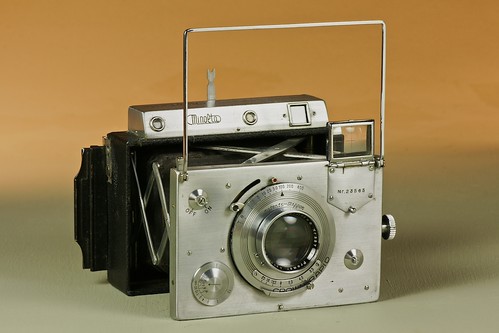Auto Press Minolta
The Auto Press Minolta (オートプレスミノルタ) is a strut-folding camera with a coupled rangefinder, taking 6.5×9cm plates or film sheets, made from 1937 by Chiyoda Kōgaku Seikō (predecessor of Minolta). It was an upgraded successor of the Auto Minolta.
Contents
Description
The Auto Press Minolta was much inspired by the Plaubel Makina IIS but has a reversed configuration, with the viewfinder on the photographer's left, and has a number of other differences, including some features which were absent on the contemporary Makina.
Configuration, viewing and focusing
The main body is the same as on the Auto Minolta, but reversed. The rectangular front plate is chrome-finished. It is mounted on scissor struts offset to the left, attached to a spring-loaded shaft. There are smaller struts on the right, and a single tripod thread at the bottom.. The camera is opened by a small button placed on the right-hand side of the body, under the leather handle. To close the camera, the scissor struts are unlocked by a button placed between the lens and focusing wheel.
 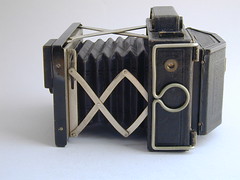
|
| Auto Press Minolta (left) vs Auto Minolta (right). The body and struts are the same, but reversed. Pictures by eBayer hbpartner. (Image rights) |
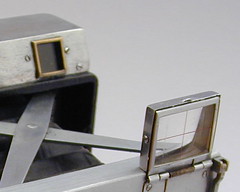 
|
| Viewfinder, open. (Image rights) |

|
| Viewfinder, closed. (Image rights) |
There is a chrome-finished top housing covering the whole length of the body. It contains the viewfinder eyepiece at the left end, providing automatic parallax correction. The viewfinder's main glass element is hinged to the front plate and has a crosshair; the hinge is spring-loaded and the element is maintained in retracted position by a small pin. The automatic parallax correction feature was very novel at the time, and the Auto Press Minolta was perhaps the first Japanese camera to incorporate it. It might have been the main reason to reverse the Auto Minolta's body, to have the scissor struts' main axis just below the viewfinder for easier coupling of the parallax correction device to the focusing mechanism.

|
| Rangefinder casing. (Image rights) |
The coupled rangefinder is contained in the right side of the top housing. It has two windows at the front and an eyepiece offset to the left, not far from the viewfinder eyepiece. The camera also has a wireframe finder hinged to the top corners of the front part, used in conjunction with a retractable bead placed behind the top housing.
The camera is focused by turning a small knob controlling the angle of the main struts, placed at the left end of the front plate (this layout is symmetrical to that of the Auto Minolta). The distance is indicated by a circular scale rotating around a fixed arrow index. The scale is graduated from ∞ down to 1m, and the central index has depth-of-field indications; the whole device is placed at the bottom left of the lens, as seen from the front. The position of the index varies on the actual cameras found today, and some are reported to give bad distance readings. It is not known if the cameras left the factory with varying index positions, or if these are the result of incompetent repair or accidental drift from the original setting. (One original picture shows the distance index pointing downwards, at about five o'clock,[1] but the standard position on most cameras seems to be at nine o'clock.)
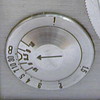  
|
| Distance dial, showing various positions of the central index. (Image rights) |

|
| Promar Anastigmat Nippon 105mm f/3.5 lens and Crown-Rapid shutter. (Image rights) |
Lens, shutter and flash synchronization

|

|
| Scheme and description of the Promar lens. (Image rights) |
The lens is fixed, unlike that of the Plaubel Makina. It is a four-element Promar Anastigmat Nippon 105mm f/3.5, made by Asahi Kōgaku (predecessor of Pentax).[2] This lens was similar to the Promar Anastigmat Nippon 75mm f/3.5 lens mounted at the same time on the Auto Semi Minolta. The same company Asahi Kōgaku was already supplying the Coronar Anastigmat Nippon and Actiplan Anastigmat Nippon lenses of other Minolta cameras.
The shutter is a rim-set Crown-Rapid (T, B, 1–400) in #1 size, made by the Chiyoda company itself.[3] The winding lever, at the top of the shutter casing, has a black dot and runs in a slit of the front plate. The self-timer button, going through the front plate, is smaller and has a red dot. The shutter plate is silver and has the words Patents–Nippon engraved at the top, and an aperture scale from 3.5 to 25 screwed at the bottom. The long aperture lever is shaped as a scythe and runs in an indent of the front plate, under the shutter casing. The shutter name CROWN–RAPID is inscribed at the bottom of the speed setting rim.
 
|
| Release button and flash selector. (Image rights) |
The main release protrudes at the top right corner of the front standard (as seen by the photographer), and contains a thread for a cable release. There is an indent in the main body, to accommodate the release button when the camera is folded.

|
| Flashgun attachments. (Image rights) |
The camera has two attachments for a flashgun on the left-hand side of the main body. Flash synchronization is actuated by the movement of the shutter's winding lever, and is effective at 1/50 speed.[4] There is a selector on the front plate, near the main release, with ON and OFF indications, perhaps used to engage or shut the synch connection. The synch contact is transmitted by the auxiliary struts to the bottom flashgun attachment, allowing cordless operation.[5] The Auto Press Minolta was the first Japanese camera synchronized for flash, and was maybe the first camera in the world to have a hot shoe.
Markings, dimensions and weight

|
| (Image rights) |
The model name Auto Press is engraved in a stylized form above the top housing, and the brand name Minolta is at the front, between the two rangefinder windows, in a similar stylized form, the same as on the contemporaneous Auto Semi Minolta. The model name AUTO PRESS is also embossed on the leather handle, and the brand name Minolta is embossed on the original ground glass hood and film pack holder at least. The body serial number is engraved on the viewfinder's front element support, with an Nr. prefix.
The dimensions of the camera are 140×118×133mm, and the weight is 1,300g.[6]
Commercial life
The Auto Press Minolta was announced in late 1937,[7] and was featured in the December 1937 issue of Asahi Camera.[8] It was displayed in the show organized the same month in the Tōkyō Kaikan by Chiyoda Kōgaku Seikō and Asanuma Shōkai to celebrate their new commercial agreements.[9]

|
| Auto Press Minolta in the July 1938 catalogue and price list by Asanuma Shōkai. Scan by A. Apra. (Image rights) |
The earliest reported advertisement is in the January 1938 issue of Asahi Camera.[10] It shows no picture of the Auto Press Minolta, which is listed at ¥265.[11] This price is very expensive, but is thirty yen less than the Auto Minolta with Tessar and Compur.
The July 1938 catalogue by Asanuma Shōkai shows the camera with the flashgun attached to the side.[12] This camera has the early type of wireframe with straight sides, and is thus an early production example (see below). The price is given as ¥290 in the corresponding price list, including six plate holders and a pack holder.[13]

|
| Auto Press Minolta in the October 1941 catalogue by Asanuma Shōkai. (Image rights) |
The advertisement in Shashin Shinpō January 1940 shows another picture of the camera with flashgun.[14] The pictured example already has the later type of wireframe with stepped sides (see below). The price is ¥310, making it the most expensive Japanese camera with the exception of the few Leica copies. The same price of ¥310 is given in the official list of set prices compiled in October 1940 and published in January 1941.[15]
The October 1941 catalogue by Asanuma Shōkai has a page about the Auto Press Minolta, priced at ¥363.[16] The April 1943 government inquiry on Japanese camera production still lists the Auto Press Minolta; this is the last known mention of the camera.[17]
Actual examples
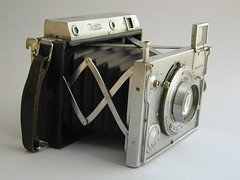  
|

|

| |
| Auto Press Minolta no.24775, Promar Anastigmat Nippon 105mm f/3.5 lens no.104663, Crown-Rapid shutter, stepped wireframe, no strap lugs. Pictures by eBayer hbpartner. (Image rights) | |
The known surviving examples have a body number in the 23xxx to 27xxx range, accounting for a total production of less than 5,000 units.[18]
Few variations are visible. The very early cameras have a straight wireframe. This was replaced by a newer wireframe with stepped sides very soon. At about the same time, a screw appeared on the front plate, next to the on/off selector, in addition to the screw that was already present around that place.
Some examples have strap lugs on each side of the body, at the top. These lugs are irregularly distributed; they are more frequent on early cameras, and it seems that they completely disappeared after no.25000.
 
|
 
|

| |
| Auto Press Minolta no.26748, Promar Anastigmat Nippon 105mm f/3.5 lens no.108482, Crown-Rapid shutter, stepped wireframe, no strap lugs. Pictures by S. Montagna. (Image rights) | |
On most examples, the top housing is attached by four screws placed at the middle of each side. The remaining cameras have two screws at the front and two at the rear, near the ends of the long sides. The latter configuration is more frequent on late examples, but no definitive pattern can be drawn.
 
|
| These two top casings differ only by the position of the attachment screws. (Image rights) |
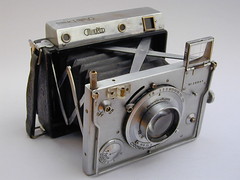 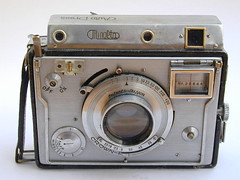 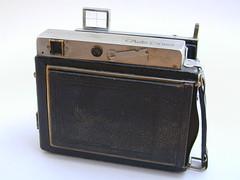
|
| Auto Press Minolta no.26844, Promar Anastigmat Nippon 105mm f/3.5 lens no.108588, Crown-Rapid shutter, stepped wireframe, no strap lugs. Pictures by eBayer hbpartner. (Image rights) |
Cameras showing non-standard variations are not infrequent, probably reflecting the fact that the Auto Press Minolta was used by professional photo-journalists, who had their cameras modified and repaired more frequently than amateurs. For example, some cameras have a synch socket added in the front plate,[19] others have the flashgun attachments removed, one camera is reported with the ON indication of the flash synch selector painted in red, and one has been found with a non original Compur shutter, a Carl Zeiss 10.5cm lens and a heavier focusing knob.[20]
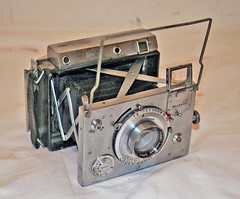 
|
| Auto Press Minolta, Promar Anastigmat Nippon 105mm f/3.5 lens, Crown-Rapid shutter, stepped wireframe, no strap lugs, modified with an added flash synch pin. Pictures courtesy of Jay Tepper. (Image rights) |
A radically modified example was presented in the October 1954 issue of Shashin Kōgyō. Pictures of this impressive machine, work of Okitsu Takeo (興津武雄), are reproduced below. The fate of this camera is unfortunately unknown.
  
|
 
|
| Auto Press Minolta modified by Okitsu Takeo, presented in Shashin Kōgyō October 1954. (Image rights) |

|
| Serial number. (Image rights) |
Production
The Auto Press Minolta were produced in the company's original Mukogawa (武庫川) plant, together with the other bellows models, at a rate of about 100 units per month.[21] The known body numbers range from 234xx to 271xx, in a sequence which is certainly continuous and specific to the model. Total production can be estimated at less than 4,000 units; a number which is consistent with the monthly rate.
Accessories
The camera was supplied as a set with six plate holders, a film pack holder and a lens cap.[22] The following accessories were offered separately:[23]
- lens hood, holding 40mm diameter filters, ¥1.90 in 1938 and 1941;
- flashgun, ¥13 in 1938, 1940 and 1941;
- leather case (皮製ケース), ¥8 in 1938, then ever-ready case (速写ケース), ¥8 in 1940, ¥11.65 in 1941;
- rigid "portable case" (携帯ケース), ¥10 in 1940, ¥11.85 in 1941.
The lens cap is all chrome, and covers the lens only, unlike the lens cap of the Minolta and Auto Minolta covering the whole lens and shutter unit. The ground glass hood and film pack holder have the brand name Minolta embossed in the leather covering, and have chrome fittings.
 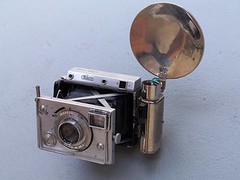 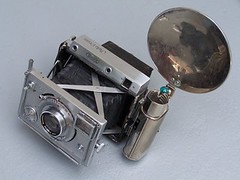
|
 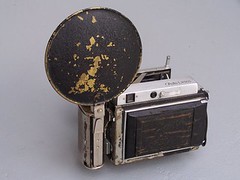 
|
| Auto Press Minolta with flashgun. Pictures by Igor Stowbunenko. (Image rights) |
The flashgun mainly consists of a large leatherette-covered battery compartment, hinged at the front and providing a grip to hold the camera steadily. The bulb holder is at the top, and the circular reflector is attached at the top rear. The device takes two batteries in serial connection. There is a small test light behind the bulb holder, certainly indicating if the batteries have enough power to fire the main bulb. An original document mentions 3V batteries — certainly corresponding to the total voltage of the two battery elements, perhaps sold as a single pack — and a voltmeter (ボルトメーター) — certainly corresponding to the test light.[24] This flashgun is very rare, and only very few examples have been observed.[25]
The ever-ready case is made of brown leather, and closely fits the camera's shape.[26] The latch is at the top, and there is a Minolta logo embossed at the front. The black "portable case" is larger and allows to take the camera with its plate and film pack holders. It is not known if it can hold the flashgun as well. The same Minolta logo is embossed at the front of the case.
The camera and flashgun were sold in separate boxes made of red cardboard.[27]
Notes
- ↑ Picture in the July 1938 catalogue by Asanuma Shōkai, p.5.
- ↑ Made by Asahi Kōgaku: "Kokusan shashinki no genjōchōsa" ("Inquiry into Japanese cameras"), lens item N2.
- ↑ A version with Compur shutter is mentioned in the official chronology "Hensen kamera ichiran-pyō", p.295 of Shashin Kōgyō no.77 (reproduced in this Flickr page by Rebollo_fr). This is certainly a mistake.
- ↑ Effective at 1/50: advertisement in Shashin Shinpō January 1940 reproduced in Kokusan kamera no rekishi, p.96, and catalogue by Asanuma Shōkai dated October 1941, p.14, reproduced in this page. McKeown, p.673, says that the camera is synched at all speeds but this is a mistake.
- ↑ A camera was tested with an ohm-meter to check this.
- ↑ Scheibel, p.25.
- ↑ The fifty-year history Minolta 50-nen no ayumi, p.65, says September 1937, but the month is unconfirmed.
- ↑ Kokusan kamera no rekishi, p.341.
- ↑ Tashima Gizō, interviewed by Saeki Kakugorō on p.77 of Kurashikku Kamera Senka no.12, says November 1937, but Awano, p.7 of the same magazine, specifies that the show was inaugurated on December 12, 1937.
- ↑ Advertisement reproduced in Tanimura, p.15 of Camera Collectors' News no.118. This is the earliest advertisement listed in Kokusan kamera no rekishi, p.341.
- ↑ The release price is quoted as ¥290 in Minolta 50-nen no ayumi, p.65, and as ¥310 in Scheibel, p.25, and Francesch, pp.24 and 79. These correspond to prices asked for the Auto Press Minolta at a later date.
- ↑ July 1938 catalogue by Asanuma Shōkai, p.5.
- ↑ July 1938 price list by Asanuma Shōkai, p.4.
- ↑ Advertisement reproduced in Kokusan kamera no rekishi, p.96.
- ↑ "Kokusan shashinki no kōtei kakaku", type 8, section 5.
- ↑ Catalogue Shashinki to zairyō by Asanuma Shōkai, dated October 1941, p.14, reproduced in this page.
- ↑ "Kokusan shashinki no genjōchōsa" ("Inquiry into Japanese cameras"), item 184.
- ↑ Numbers are known from 23565 to 27153.
- ↑ The example pictured in Kamera no ayumi, p.58, owned by the Pentax Gallery, has a synch post added under the lens and a Cherry flashgun (not an originally accessory).
- ↑ On this camera, the adaptation of the #0-size Compur shutter is not seamless and it is almost certain that the equipment is not original.
- ↑ Mukogawa plant: Awano, p.7 of Kurashikku Kamera Senka no.12. Monthly production: Tashima Gizō, interviewed by Saeki Kakugorō on p.78 of Kurashikku Kamera Senka no.12.
- ↑ July 1938 price list by Asanuma Shōkai, p.4, reproduced in this page (does not mention the lens cap); January 1940 advertisement in Shashin Shinpō reproduced in Kokusan kamera no rekishi, p.96 (does not mention the lens cap); October 1941 catalogue by Asanuma Shōkai, p.14, reproduced in this page.
- ↑ 1938 prices: July 1938 price list by Asanuma Shōkai, p.4, reproduced in this page. 1940 prices: advertisement in Shashin Shinpō January 1940 reproduced in Kokusan kamera no rekishi, p.96. 1941 prices: October 1941 catalogue by Asanuma Shōkai, p.14, reproduced in this page.
- ↑ July 1938 price list by Asanuma Shōkai, p.4, reproduced in this page.
- ↑ Examples pictured in this page, in Kokusan kamera no rekishi, p.12, and in Eimukku 735 Minolta, p.127.
- ↑ Ever-ready case visible in the example sold as lot no.650 of Westlicht Photographica Auction no.10, linked below.
- ↑ Original boxes visible in Eimukku 735 Minolta, p.127.
Bibliography
Original documents
- Asanuma Shōkai. Cameras — All other apparatus and materials — 1938. Catalogue dated July 1938, p.5, and corresponding price list, p.4. Documents partly reproduced in this Flickr album by Rebollo_fr.
- Asanuma Shōkai. Shashinki to zairyō (写真機と材料, Cameras and supplies). Catalogue dated October 1941, p.14. Document partly reproduced in this Flickr album by Rebollo_fr.
- "Kokusan shashinki no genjōchōsa" (国産写真機ノ現状調査, Inquiry into Japanese cameras), listing Japanese camera production as of April 1943. Reproduced in Supuringu kamera de ikou: Zen 69 kishu no shōkai to tsukaikata (スプリングカメラでいこう: 全69機種の紹介と使い方, Let's try spring cameras: Presentation and use of 69 machines). Tokyo: Shashinkogyo Syuppan-sha, 2004. ISBN 4-87956-072-3. Pp.180–7. Item 184.
- "Kokusan shashinki no kōtei kakaku" (国産写真機の公定価格, Set prices of the Japanese cameras), listing Japanese camera production as of October 25, 1940 and setting the retail prices from December 10, 1940. Published in Asahi Camera January 1941 and reproduced in Shōwa 10—40nen kōkoku ni miru kokusan kamera no rekishi (昭和10〜40年広告にみる国産カメラの歴史, Japanese camera history as seen in advertisements, 1935—1965). Tokyo: Asahi Shinbunsha, 1994. ISBN 4-02-330312-7. Pp.108—9. Type 5, section 9.
Older historical accounts
- Minolta Camera. Minolta 50-nen no ayumi (Minolta・50年のあゆみ, Minolta 50-year history). November 1978. Pp.6 and 65.
- Shashin Kōgyō no.77 (September 1958). "Hensen kamera ichiran-pyō" (変遷カメラ一らん表, Table of camera evolution.) P.295. (This is a chronology of Minolta cameras from the Nifcarette onwards. This document is reproduced in this Flickr page by Rebollo_fr.)
- Taniguchi Masao (谷口匡男), from the commercial department (営業部) of Chiyoda Kōgaku Seikō. "Minoruta kamera no sakujitsu, konnichi" (ミノルタ・カメラの昨日、今日, Minolta cameras, yesterday and today). In Shashin Kōgyō no.77 (September 1958). Pp.275–9.
Collectors' sources
- Asahi Camera (アサヒカメラ) editorial staff. Shōwa 10–40nen kōkoku ni miru kokusan kamera no rekishi (昭和10–40年広告にみる国産カメラの歴史, Japanese camera history as seen in advertisements, 1935–1965). Tokyo: Asahi Shinbunsha, 1994. ISBN 4-02-330312-7. Item 271. (See also the picture on p.12.)
- Awano Mikio (粟野幹男). "Minoruta ryakushi" (ミノルタ略史, "Minolta short history"). Kamera Rebyū: Kurashikku Kamera Senka (カメラレビュー クラシックカメラ専科) / Camera Review: All about Historical Cameras no.12, October 1988. No ISBN number. Minoruta kamera no subete (ミノルタカメラのすべて, special issue on Minolta). Pp.6–8.
- Awano Mikio (粟野幹男). "Senzen no Minoruta kamera" (戦前のミノルタカメラ, "Prewar Minolta cameras"). Kamera Rebyū: Kurashikku Kamera Senka (カメラレビュー クラシックカメラ専科) / Camera Review: All about Historical Cameras no.12, October 1988. No ISBN number. Minoruta kamera no subete (ミノルタカメラのすべて, special issue on Minolta). Pp.13–7.
- Baird, John R. The Japanese Camera. Yakima, WA: Historical Camera Publications, 1990. ISBN 1-879561-02-6. P.42 (picture only).
- Eimukku 735, Manyuaru Kamera Shirīzu 15 (エイムック735・マニュアルカメラシリーズ15). Minolta: Minoruta kamera no subete (Minolta:ミノルタカメラのすべて, Minolta: all of Minolta cameras). Tokyo: Ei Shuppansha, 2003. ISBN 4-87099-923-4. "Jabara-shiki kamera no kiseki" (蛇腹式カメラの軌跡", Evolution of folding cameras). Pp.127, 131 and 133. (Shows very small pictures and brief captions — one of the pictures shows a complete outfit with flashgun, cap, hood, user manual and original boxes.)
- Francesch, Dominique and Jean-Paul. Histoire de l'appareil photographique Minolta de 1929 à 1985. Paris: Dessain et Tolra, 1985. ISBN 2-249-27685-4. Pp.23–4 and 79.
- Kamera no ayumi. Zen nihon shashin renmei sōritsu 50-shūnen kinen (カメラのあゆみ・全日本写真連盟創立五〇周年記念, History of cameras, commemorating the 50th anniversary of the All Japan Association of Photographic Societies). Tokyo: Asahi Shinbunsha, 1976. No ISBN number. P.58.
- Kikan Classic Camera 14 Tokushū: Minoruta Rokkōru densetsu (季刊クラシックカメラ14・特集ミノルタロッコール伝説, special: Minolta Rokkor legend). Tokyo: Futabasha, 2002. ISBN 4-575-47427-4. Picture on p.6. (This special issue on Minolta mainly treats postwar SLR cameras, and has little information on the Auto Press.)
- Lewis, Gordon, ed. The History of the Japanese Camera. Rochester, N.Y.: George Eastman House, International Museum of Photography & Film, 1991. ISBN 0-935398-17-1 (paper), 0-935398-16-3 (hard). Pp.54 and 182.
- McKeown, James M. and Joan C. McKeown's Price Guide to Antique and Classic Cameras, 12th Edition, 2005-2006. USA, Centennial Photo Service, 2004. ISBN 0-931838-40-1 (hardcover). ISBN 0-931838-41-X (softcover). P.673.
- Noma Toshio (野間俊夫). Kyorikei-tsuki kamera no henpo (距離計付きカメラの変遷, Evolution of rangefinder cameras). Gendai Kamera Shinsho (現代カメラ新書) 65. Tokyo: Asahi Sonorama, 1979. No ISBN number. Pp.37–8.
- Saeki Kakugorō (佐伯恪五郎). "Tashima Gizō-shi ni kiku" (田嶋義三氏に聞く, "Asking Tashima Gizō"). Kamera Rebyū: Kurashikku Kamera Senka (カメラレビュー クラシックカメラ専科) / Camera Review: All about Historical Cameras no.12, October 1988. No ISBN number. Minoruta kamera no subete (ミノルタカメラのすべて, special issue on Minolta). Pp.76–9.
- Scheibel, Anni Rita and Joseph. 70 Jahre Minolta Kameratechnik — Von der Nifcalette bis zur Dynax 9. Stuttgart: Lindemanns Verlag, 3rd edition, 1999. ISBN 3-89506-191-3. Pp.24–5.
- Sugiyama, Kōichi (杉山浩一); Naoi, Hiroaki (直井浩明); Bullock, John R. The Collector's Guide to Japanese Cameras. 国産カメラ図鑑 (Kokusan kamera zukan). Tokyo: Asahi Sonorama, 1985. ISBN 4-257-03187-5. Items 1198.
- Tanimura Yoshihiko (谷村吉彦). "Semi Minoruta I-gata to II-gata." (セミミノルタⅠ型とⅡ型, "Semi Minolta I and II") In Camera Collectors' News no.116 (February 1987). Nishinomiya: Camera Collectors News-sha. (Contains a reproduction of the chronology in Shashin Kōgyō no.77 and no other information on the Auto Press Minolta.)
- Tanimura Yoshihiko (谷村吉彦). "Supuringu kamera <Semi Minoruta>" (スプリングカメラ<セミミノルタ>, "'Semi Minolta' self-erecting camera"). Kamera Rebyū: Kurashikku Kamera Senka (カメラレビュー クラシックカメラ専科) / Camera Review: All about Historical Cameras no.12, October 1988. No ISBN number. Minoruta kamera no subete (ミノルタカメラのすべて, special issue on Minolta). Pp.19–24. (Contains a reproduction of an advertisement showing the Auto Press Minolta, and no other information on the camera.)
Links
In English:
- Auto Press Minolta in the 70th anniversary Minolta poster, reproduced at Photoclub Alpha
- Auto Press Minolta, lot no.650 of the tenth Westlicht Photographica Auction (18 November 2006)
In Japanese:
- Auto Press Minolta in the Camera database at the Center of the History of Japanese Industrial Technology
- Auto Press Minolta in a page of wanted cameras at Classic Camera List, archived in 2016 at archive.org
- Auto Press Minolta in Fotomegu's Flickr gallery
- Auto Press Minolta at Map Camera Museum (archived 2007 at archive.org)
| Nifca, Molta and Chiyoda prewar and wartime cameras () | |
|---|---|
| folding plate cameras | |
| Nifcaklapp | Nifcasport | Sirius | Arcadia | Lomax | Eaton | Happy | |
| folding rollfilm cameras | telescopic bakelite cameras |
| Nifcarette | Sirius Bebe | Semi Minolta | Auto Semi Minolta | Minolta Vest | Baby Minolta | Minolta Six |
| strut-folding cameras | TLR cameras |
| Nifca-Dox | Minolta | Auto Minolta | Auto Press Minolta | Minoltaflex | Minoltaflex Automat | Minoltaflex military prototype |
